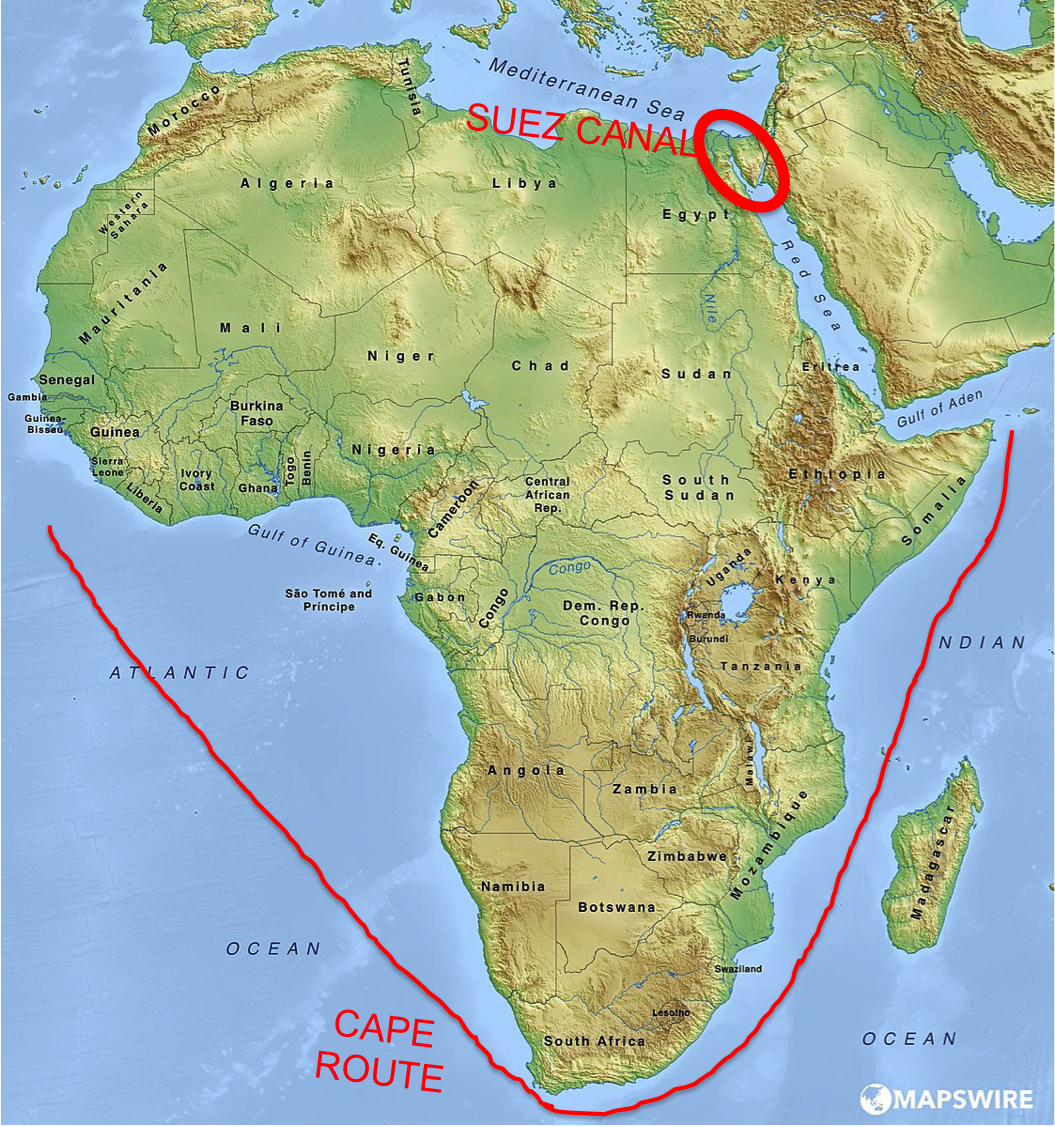Escalations in Red Sea, More Diversions, More Ships, More Freight Rate Pressure
Missile Strikes U.S. Cargo Ship
A CBS News video reports that the Iran-backed Houthi rebels, who have been attacking ships in the Red Sea, hit the U.S. cargo ship Gibraltar Eagle with a missile strike off the coast of Yemen in the Gulf of Aden, which connects the Indian Ocean and Arabian Sea to the Red Sea. From the anti-ship ballistic missile, “the vessel suffered limited damage to a cargo hold but is stable and is heading out of the area.” There were no injuries reported.
The attack follows U.S. and U.K. cooperative air strikes across Yemen, targeting Houthi forces in response to the Houthi attacks that have been happening in the Red Sea. The air raids obviously did not deter Houthi rebels from launching missiles at ships. They also fired an anti-ship cruise missile, after the air raids, at the U.S.S. Boone Destroyer in the Red Sea, but the missile was shot down by a fighter jet.
Unfortunately, this means the situation in the Red Sea is only escalating, which for shippers means…
Ongoing Diversions from Red Sea for Foreseeable Future, According to Geopolitical Analylists
According to a Journal of Commerce (JOC) article by Mark Szakonyi, geopolitical analysts see ship diversions from the Red Sea and Suez Canal to down and around southern Africa’s Cape of Good Hope to stay away from Houthi attacks to continue for the foreseeable future.

While it’s too soon to determine what impact joint US-UK air strikes on the Houthis will have, experts warn it’s unlikely to deter the Iran-backed group from future attacks. The Houthis — seeing their regional influence rise and galvanized by wider anger among Arab states amid the Israel-Hamas war — have plenty to gain by keeping up their attacks via drones and cruise and ballistic missiles, according to Jack Kennedy, associate director of country risk for the Middle East and North Africa at S&P Global Market Intelligence.
“The group is unlikely to be deterred,” Kennedy told the Journal of Commerce….
A US aircraft carrier and submarines hit more than 60 Houthi-linked targets at 16 sites in Yemen last week, followed up by two subsequent strikes.
While the attacks may have helped US forces weaken the ability of militants to target commercial ships, they won’t likely deter the Houthis or their Iranian backers, said Bruce Jones, a geopolitical analyst at the Brookings Institution. Being widely dispersed across western Yemen, the Houthis can easily move, hide and launch drone strikes from anywhere, he said.
“We should expect to see continued uncertainty in the Red Sea in the days and probably weeks ahead,” Jones said.
There’s nothing surprising about what the geopolitical experts said. Frankly, with this article being published today (January 16th), after the Houthi militants have continued attacking after the air raids, any layman following the news could tell you the U.S.-U.K. air strikes did not stop Houthi attacks and ship diversions will continue.
With the much longer transit times of ships going around the whole continent of Africa…
It Takes More Ships
More ships are required to handle the longer routes around Africa while keeping all the other port to port services carriers offer going. Bottom line, it takes more ships to transport the same amount of cargo.
Regular readers of Universal Cargo’s blog likely already know that more ships and capacity have been and are entering the international shipping waters. Many analysts thought carriers were bringing too many ships, too much capacity, into the market. That increased capacity beyond likely growth of demand was likely to put downward pressure on freight rates, which shippers like but can be very bad for ocean freight carriers. Now, those added ships look like a good thing for carriers, at least in the short-term.
Szakonyi points to the new and incoming vessels as the capacity being available to handle longer transits:
… container lines have plenty of ships to deploy on these now-longer services that require more vessels to keep to schedule. Container capacity is expanding 10% this year from 2023 while demand growth will be between 3% to 4%, according to the Baltic and International Maritime Council (BIMCO).
However, all the carriers don’t seem quite as set on ships as Szankonyi makes it sound. According to a Miller Time (Greg Miller) article in FreightWaves, container lines are scrambling to rent more ships to handle the situation.
This scrambling demand means higher rates for chartering ships. Of course, the higher cost of shipping will likely be passed on to shippers, who have already seen freight rates spike in the wake of the Red Sea attacks.
Miller Time reports:
“This week saw a scramble for prompt tonnage,” said MB Shipbrokers (formerly Maersk Broker) in a market report on Friday, referring to ships that can be chartered immediately.
“Owners have certainly become more bullish and are pushing for higher-than-last-done levels in all segments and most regions.” Charter rates are headed higher, “specifically for short periods of three to six months’ duration,” said MB Shipbrokers.
Shipbroker Braemar reported Sunday: “Chartering activity [has] further improved. Various prompt vessels across all sizes and regions [are] seeing increased interest. Charter rates as well as periods are witnessing a firming trend.”
…
“Despite a continued influx of newbuilding tonnage of all types, demand for most sizes of charter-market ships … remains strong. The crisis in the Red Sea, with most carriers now avoiding the area, is in part contributing to the market’s brisk activity,” said Alphaliner.
Because of the already mentioned ships entering the waters, 2024 was expected to be a weak year for chartering ships. That means the current supply of ships available to be chartered is not up to the influx in demand, putting even more upward pressure on chartering costs. Miller Time writes about how most of the charter tonnage out there from non-operating owners (NOOs) is already tied up in long-term leases.
During the supply chain crisis, there was heavy demand to charter ships, so NOOs were able to dictate terms for not only historically high rates but also forcing container lines to take multi-year leases. Miller Time demonstrated how most of these ships are already chartered with the following data:
Among the U.S.-listed NOOs, Danaos (NYSE: DAC) has 90% of its fleet already locked up on charters through the end of 2024. Charter coverage of Costamare (NYSE: CMRE) is 87% for 2024, with Global Ship Lease (NYSE: GSL) at 82% and Euroseas (NASDAQ: ESEA) at 70%.
It all adds up to…
Conclusion
Ultimately, the ongoing and intensifying situation in the Red Sea and longer shipping routes to avoid it mean continuing upward pressure on freight rates. I know that’s something shippers don’t like to hear, but at least we are coming up on a slower time of year for international shipping. The lower demand after the Chinese New Year starts is a downward pressure on rates. The potential for some relief for shippers in the near future is something you can read about in our post:
Good News for Shippers in Wake of Red Sea Attacks & High Freight Rates
In the meantime, we’re looking at overall upward pressure on freight rates at the moment. And for a look at freight rate behavior projections for the year, check out our last post:
2024 Expert Freight Rate Outlook in Wake of Red Sea Attacks & Rate Spikes





